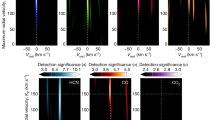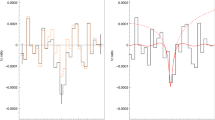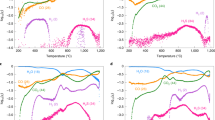Abstract
A defining characteristic of the planet Venus is its thick, CO2-dominated atmosphere. Despite over 50 years of robotic exploration of Venus, including thirteen successful atmospheric probes and landers, our knowledge of N2, the second most abundant compound in the atmosphere, is highly uncertain1. We report the first measurement of the nitrogen content of Venus’s atmosphere at altitudes between 60 and 100 km. Our result, 5.0 ± 0.4 v% N2, is 40% higher than the value of 3.5 v% N2 reported for the lower atmosphere (<50 km altitude). Our discovery of altitude-dependent variations in the N2 content of the atmosphere defies early expectations of homogeneous composition below 100 km (for example, see ref. 1), and necessitates complete chemical modelling to investigate chemical versus physical explanations for the enhanced N2 in the upper atmosphere. The existence of chemically distinct lower and upper atmosphere regions complicates the use of remote sensing measurements of the upper atmosphere to infer the properties of the lower atmosphere and surface, an important lesson that also extends to the growing field of exoplanet astronomy.
This is a preview of subscription content, access via your institution
Access options
Access Nature and 54 other Nature Portfolio journals
Get Nature+, our best-value online-access subscription
$29.99 / 30 days
cancel any time
Subscribe to this journal
Receive 12 digital issues and online access to articles
$119.00 per year
only $9.92 per issue
Buy this article
- Purchase on Springer Link
- Instant access to full article PDF
Prices may be subject to local taxes which are calculated during checkout



Similar content being viewed by others
Data availability
The MESSENGER Neutron Spectrometer data used in this study are publicly available via NASA’s Planetary Data System (https://pds-geosciences.wustl.edu/missions/messenger/index.htm). Those data include the NS LG energy spectra used to produce the measured neutron count rates shown in Fig. 1 (middle and bottom panels), as well as the spacecraft ephemeris data in Fig. 1 (top panel).
Code availability
The export-controlled MCNPX radiation transport code, which formed the basis of our modeling effort, is available from https://mcnp.lanl.gov. Data processing was handled using the Interactive Data Language (IDL), with spectral processing codes following a routine detailed in Lawrence et al.13 and standard statistical analysis (for example, reduced-χ2 analyses) as detailed in the Methods section.
References
von Zahn, U., Kumar, S., Neimann, H. & Prinn, R. in Venus (eds Hunten, D. M. et al.) 299–430 (Univ. Arizona Press, 1983).
Kliore, A. J., Moroz, V. I. & Keating, G. M. (eds) The Venus international reference atmosphere. Adv. Space Res. 5, 1–305 (1985).
McAdams, J. V., Farquhar, R. W., Taylor, A. H. & Williams, B. G. MESSENGER mission design and navigation. Space Sci. Rev. 131, 219–246 (2007).
Goldsten, J. O. et al. The MESSENGER Gamma-Ray and neutron spectrometer. Space Sci. Rev. 131, 339–391 (2007).
Lawrence, D. J. et al. Evidence for water ice near Mercury’s North Pole from MESSENGER neutron spectrometer measurements. Science 339, 292–296 (2013).
Feldman, W. C. & Drake, D. M. A Doppler filter technique to measure the hydrogen content of planetary surfaces. Nucl. Instrum. Methods Phys. Res. A 245, 182–190 (1986).
Lingenfelter, R. E., Hess, W. N. & Canfield, E. H. Neutron leakage flux and the nitrogen abundance of Venus. J. Atmos. Sci. 19, 274–276 (1962).
Pelowitz, D. B. MCNPX User’s Manual Version 2.5.0 (Los Alamos National Laboratory, 2005).
Seiff, A. et al. Models of the structure of the atmosphere of Venus from the surface to 100 kilometers altitude. Adv. Space Res. 5, 3–32 (1986).
Lodders, K. & Fegley, B. Jr The Planetary Scientist’s Companion (Oxford Univ. Press, 1998).
Peplowski, P. N. et al. Cosmogenic radionuclide production modeling with Geant4: experimental benchmarking and application to nuclear spectroscopy of asteroid (16) Psyche. Nucl. Instrum. Methods Phys. Res. 446, 43–57 (2019).
Feldman, W. C., Drake, D. M., O’Dell, R. D., Brinkley, F. W. Jr & Anderson, R. C. Gravitational effects on planetary neutron flux spectra. J. Geophys. Res. Solid Earth 94, 513–525 (1989).
Lawrence et al. Identification and measurement of neutron-absorbing elements of Mercury’s surface. Icarus 209, 195–209 (2010).
Wilson, J. T., Lawrence, D. J., Peplowski, P. N. & Feldman, W. C. MESSENGER gamma ray spectrometer and epithermal neutron hydrogen data reveal compositional differences between Mercury’s hot and cold poles. J. Geophys. Res. Planets 124, 721–733 (2019).
Arney, G. et al. Spatially resolved measurements of H2O, HCl, CO, OCS, SO2, cloud opacity, and acid concentration in the Venus near‐infrared spectral windows. J. Geophys. Res. Planets 119, 1860–1891 (2014).
Mueller, N. et al. Venus surface thermal emission at 1 μm in VIRTIS imaging observations: evidence for variation of crust and mantle differentiation conditions. J. Geophys. Res. Planets 113, E00B17 (2008).
Esposito, L. W. Sulfur dioxide: episodic injection shows evidence for active Venus volcanism. Science 223, 1072–1074 (1984).
Marcq, E., Bertaux, J.-L., Montmessin, F. & Belyaev, D. Variations of sulphur dioxide at the cloud top of Venus’s dynamic atmosphere. Nat. Geosci. 6, 25–28 (2013).
Lebonnois, S. & Schubert., G. The deep atmosphere of Venus and the possible role of density-driven separation of CO2 and N2. Nat. Geosci. 10, 473–477 (2017).
Hedelt, P. et al. Venus transit 2004: illustrating the capability of exoplanet transmission spectroscopy. Astron. Astrophys. 533, A136 (2011).
Ehrenreich, D. et al. Transmission spectrum of Venus as a transiting exoplanet. Astron. Astrophys. 537, L2 (2012).
Kane, S. R. et al. Venus as a laboratory for exoplanetary science. J. Geophys. Res. Planets 124, 2015–2028 (2019).
Senske, D. et al. Venera-D: Expanding Our Horizon of Terrestrial Planet Climate and Geology Through the Comprehensive Exploration of Venus (Venera-D Joint Science Definition Team, 2017); https://www.lpi.usra.edu/vexag/reports/Venera-D-STDT013117.pdf
Glaze, L. S., Garvin, J. B., Johnson, N. M., Atkinson, D. & Atreya, S. DAVINCI: deep atmosphere Venus investigation of noble gases, chemistry, and imaging. In 47th Lunar and Planetary Science Conf. 1560 (USRA, 2016).
Peplowski, P. N. et al. Geochemical terranes of Mercury’s northern hemisphere as revealed by MESSENGER neutron measurements. Icarus 253, 346–363 (2015).
Wiedenbeck, M. E. et al. The level of solar modulation of galactic cosmic rays from 1997 to 2005 as derived from ACE measurements of elemental energy spectra. In 29th Int. Cosmic Ray Conf. Pune 2, 277–280 (IUPAP, 2005).
Weider, S. Z. et al. Evidence for geochemical terranes on Mercury: global mapping of major elements with MESSENGER’s X-Ray Spectrometer. Earth Planet. Sci. Lett. 416, 109–120 (2015).
Acknowledgements
This analysis has benefited from many funding sources over a number of years. The MESSENGER mission was supported by the NASA Discovery Program under contract NAS5-97271 to the Johns Hopkins University Applied Physics Laboratory and NASW-00002 to the Carnegie Institution of Washington. Data analysis was originally supported, in part, by a MESSENGER Participating Scientist grant NNX08AN30G to D.J.L. Improvements to the spectral analysis and modelling codes were funded by the US Department of Energy, grant DE-SC0019343. Finally, manuscript preparation was funded by NASA’s Discovery Data Analysis Program, grant NNX16AJ949, to the Johns Hopkins University Applied Physics Laboratory.
Author information
Authors and Affiliations
Contributions
P.N.P. wrote the data-model comparison codes, derived the nitrogen concentration and wrote the initial draft of the manuscript. All authors contributed to the final manuscript. J.T.W. produced the neutron counting rate data used in this study. D.J.L. produced the modelled neutron count rates for all considered N2 concentrations.
Corresponding author
Ethics declarations
Competing interests
The authors declare no competing interests.
Additional information
Peer review information Nature Astronomy thanks Paul Byrne and the other, anonymous, reviewer(s) for their contribution to the peer review of this work.
Publisher’s note Springer Nature remains neutral with regard to jurisdictional claims in published maps and institutional affiliations.
Supplementary information
Supplementary Information
Supplementary Figs. 1–4 and Table 1.
Rights and permissions
About this article
Cite this article
Peplowski, P.N., Lawrence, D.J. & Wilson, J.T. Chemically distinct regions of Venus’s atmosphere revealed by measured N2 concentrations. Nat Astron 4, 947–950 (2020). https://doi.org/10.1038/s41550-020-1079-2
Received:
Accepted:
Published:
Issue Date:
DOI: https://doi.org/10.1038/s41550-020-1079-2
This article is cited by
-
Synergies Between Venus & Exoplanetary Observations
Space Science Reviews (2023)
-
Venus, the Planet: Introduction to the Evolution of Earth’s Sister Planet
Space Science Reviews (2023)
-
Noble Gases and Stable Isotopes Track the Origin and Early Evolution of the Venus Atmosphere
Space Science Reviews (2022)
-
The Long-Term Evolution of the Atmosphere of Venus: Processes and Feedback Mechanisms
Space Science Reviews (2022)



